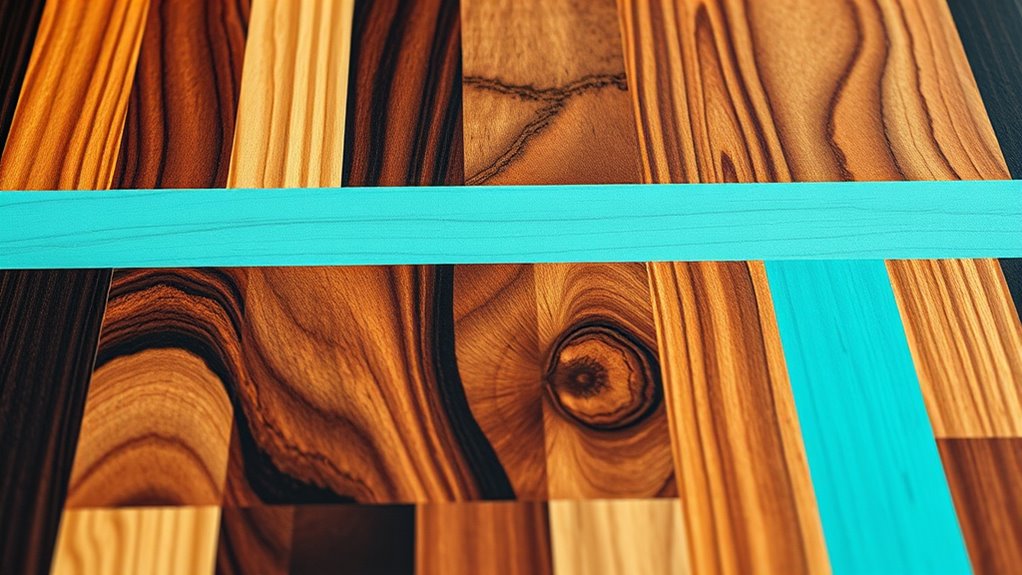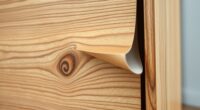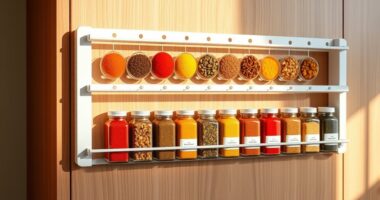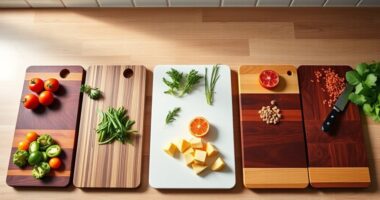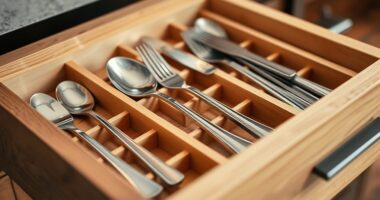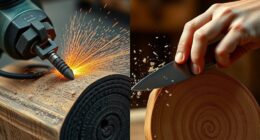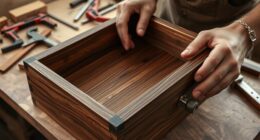To create a multi-species cutting board with accent strips, start by selecting woods with contrasting grain patterns and vibrant colors, ensuring they’re durable and water-resistant. Carefully plan your design, aligning grains for visual harmony or contrast, and incorporating accent strips as eye-catching features. Cut and assemble with tight joints, then sand smoothly. Finish with food-safe oils or finishes that highlight the natural beauty. Keep exploring to find detailed steps that make your project truly stand out.
Key Takeaways
- Select contrasting wood species with complementary grain patterns for visual interest and durability.
- Incorporate accent strips strategically to create contrast and artistic appeal within the board’s design.
- Align grain patterns during assembly to highlight natural features and ensure tight, seamless joints.
- Use finishing techniques like mineral oil or beeswax to enhance color, grain, and moisture resistance.
- Plan the layout carefully to balance aesthetics and functionality, resulting in a durable, beautiful cutting board.
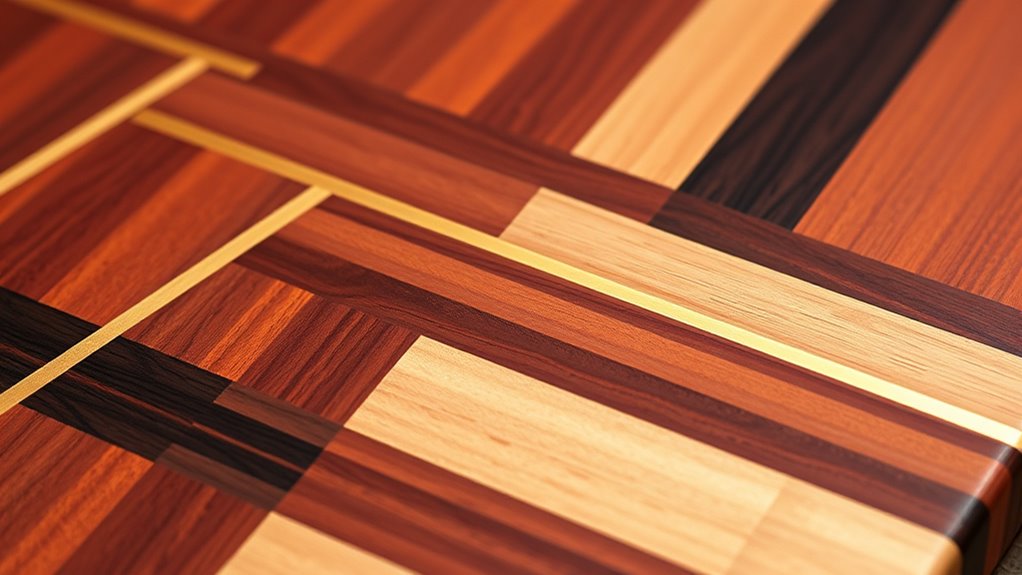
A multi-species cutting board offers a beautiful way to showcase different types of wood while providing a functional kitchen tool. When you choose to incorporate accent strips into your design, you create a striking visual contrast that elevates the entire piece. The key to making this work lies in understanding how grain patterns interact and how finishing techniques can bring out the best in each wood type. You’ll want to carefully select your woods based on their grain characteristics—some woods have tight, straight grains that lend a sleek appearance, while others display more dramatic, swirling patterns that add visual interest. Combining these variations intentionally allows you to craft a piece that’s both functional and artistic.
As you work with multiple species, pay close attention to the grain patterns. When cutting your strips, aim for consistency in thickness and width, which ensures a seamless fit and a polished look. The way different grains align or contrast can profoundly influence the final aesthetic. For instance, placing woods with contrasting grain directions can create a dynamic, checkerboard effect or a subtle, linear flow. To enhance this, you might consider planing the edges meticulously to ensure tight joints, as gaps or uneven surfaces can detract from the overall beauty. Proper alignment of the grain patterns across the board helps to highlight the natural character of each wood, making the accent strips stand out as intentional design features. Additionally, selecting woods with vetted water resistance can help prolong the lifespan of your cutting board, especially when used in a moist environment.
Finishing techniques play an essential role in accentuating the grain patterns and protecting your work. Once glued and sanded smooth, you’ll want to apply a finish that enhances the wood’s natural color and grain. Mineral oil, beeswax, or food-safe finishes are popular choices that penetrate deeply, bringing out the richness of each species. Multiple coats of finish, applied with fine-grit sanding in between, can help achieve a smooth, glossy surface that highlights the varied grain patterns. The right finishing method not only beautifies but also seals the surface against moisture and bacteria, ensuring your cutting board remains durable over time.
In the end, creating a multi-species cutting board with accent strips requires a thoughtful approach to selecting woods, aligning grain patterns, and applying the appropriate finishing techniques. Your careful attention to these details results in a piece that’s as functional as it is stunning. The contrast of different woods and the artistry of your finishing work turn a simple kitchen tool into a work of art, reflecting both your craftsmanship and your appreciation for natural beauty.
Frequently Asked Questions
What Types of Wood Are Safest for Food Contact?
You should choose non-toxic woods like maple, cherry, and walnut, which are safe for food contact. Always guarantee they’re food grade finished with food-safe, non-toxic finishes to prevent contamination. These woods are durable, naturally resistant to bacteria, and widely recommended for cutting boards. Avoid soft or oily woods that may harbor bacteria or degrade quickly. Using these safe options helps you create a beautiful, functional, and food-safe cutting surface.
How Do I Prevent the Wood From Warping Over Time?
Did you know that properly stabilized wood resists warping up to 80% better? To prevent warping over time, focus on wood stabilization and moisture control. Seal your board with food-safe oil regularly, and store it in a cool, dry place. Avoid exposing it to extreme humidity or temperature changes. These steps help maintain the board’s shape and durability, ensuring it stays flat and functional for years to come.
What Finishing Products Are Recommended for Food Safety?
You should use food grade finishes and food safe sealants to guarantee your cutting board remains safe for food contact. Look for mineral oil, beeswax, or specialized food-safe mineral sealers that are non-toxic and FDA-approved. Apply these finishes regularly to maintain a protective barrier, preventing moisture absorption and bacterial growth. Always follow the manufacturer’s instructions, and reapply as needed to keep your board safe and well-preserved over time.
How Do I Properly Clean and Maintain the Cutting Board?
To properly clean and maintain your cutting board, wash it with warm water and mild soap after each use. Rinse thoroughly and dry completely to prevent bacteria growth. Apply board oil regularly to keep the wood hydrated and protected. For sanitizing, use a diluted vinegar solution or a commercial sanitizer. Avoid soaking the board in water, and reapply board oil periodically to maintain its condition and guarantee food safety.
Can I Incorporate LED Lighting Into the Design?
Yes, you can incorporate LED integration into your cutting board design for ambient lighting. Use waterproof, food-safe LEDs that can be safely embedded around the edges or beneath accent strips. This adds a stylish glow and improves visibility during use. guarantee the lighting system is properly sealed and insulated to prevent moisture damage. With careful planning, LED integration enhances both the functionality and aesthetic appeal of your multi-species cutting board.
Conclusion
As you finish your multi-species cutting board, remember that beauty lies in contrast. The rich, dark hues of one wood highlight the vibrant, lighter tones of another—each species distinct yet harmonious. Just like life, this piece proves that diversity can create something both functional and stunning. Embrace the imperfections and variations, for they’re what make your creation truly unique, blending nature’s complexity into a simple, everyday tool.
